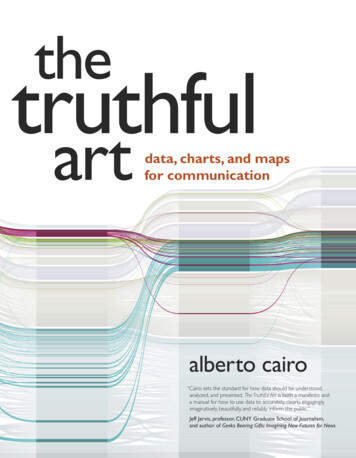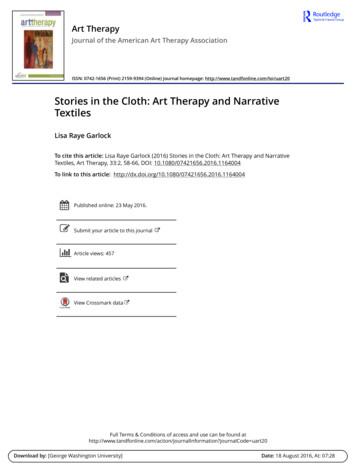
Transcription
thetruthfulartdata, charts, and mapsfor communicationalberto cairo“Cairo sets the standard for how data should be understood,analyzed, and presented. The Truthful Art is both a manifesto anda manual for how to use data to accurately, clearly, engagingly,imaginatively, beautifully, and reliably inform the public.”Jeff Jarvis, professor, CUNY Graduate School of Journalism,and author of Geeks Bearing Gifts: Imagining New Futures for News
Praise for The Truthful Art“ Alberto Cairo is widely acknowledged as journalism’s preeminent visualization wiz.He is also journalism’s preeminent data scholar. As newsrooms rush to embracedata journalism as a new tool—and toy—Cairo sets the standard for how datashould be understood, analyzed, and presented. The Truthful Art is both a manifestoand a manual for how to use data to accurately, clearly, engagingly, imaginatively,beautifully, and reliably inform the public.”— Jeff Jarvis, professor at CUNY Graduate School of Journalism and author ofGeeks Bearing Gifts: Imagining New Futures for News“ A feast for both the eyes and mind, Alberto Cairo’s The Truthful Art deftly exploresthe science—and art—of data visualization. The book is a must-read for scientists,educators, journalists, and just about anyone who cares about how to communicateeffectively in the information age.”— Michael E. Mann, Distinguished Professor, Penn State University and author ofThe Hockey Stick and the Climate Wars“ A lberto Cairo is a great educator and an engaging storyteller. In The Truthful Art hetakes us on a rich, informed, and well-visualized journey that depicts the processby which one scrutinizes data and represents information. The book synthesizesa lot of knowledge and carefully explains how to create effective visualizationswith a focus on statistical principles. The Truthful Art will be incredibly useful toboth practitioners and students, especially within the arts and humanities, suchas those involved in data journalism and information design.”— Isabel Meirelles, professor at OCAD University (Canada) and author ofDesign for Information“ As soon as I started immersing myself in The Truthful Art, I was horrified (andsomewhat ashamed) to realize how much I didn’t know about data visualization.I’ve spent most of my career pursuing a more illustrative way to present data, butAlberto Cairo’s clarifying prose superbly explained the finer points of data viz. SinceAlberto warns us that “[data is] always noisy, dirty, and uncertain,” everyone in thisbusiness had better read his book to find out how to properly construct visualizationsthat not only tell the truth, but also allow us to interact meaningfully with them.”—Nigel Holmes, founder of Explanation Graphics
“ To communicate data clearly, you have to think about it clearly. The Truthful Artdives deep and provides an enlightened introduction to the ‘power tools’ of dataexperts: science, statistics, and visualization.”—Fernanda Viégas and Martin Wattenberg, Google“ The Truthful Art is essential reading for my visual communication students and foranyone (at any level) who cares about telling a story visually. Get this book, readit, act on it. If you’re looking for help to put your data visualization on the righttrack, this is it.”—John Grimwade, School of Visual Communication, Ohio University“ If I were smarter, had more patience with academia, and was more focused, Imight turn out to be more like Alberto, closer to the brilliance that he applies tothe nature of information architecture. His title explains a lot: truth represents amost fundamental of attitudes, in questions asked, answers given, and journeystaken. This [book] is a must on your thoughtful shelf of understanding.”—Richard Saul Wurman, founder of the TED Conference
thetruthfulartdata, charts, and mapsfor communicationalberto cairo“Cairo sets the standard for how data should be understood,analyzed, and presented. The Truthful Art is both a manifesto anda manual for how to use data to accurately, clearly, engagingly,imaginatively, beautifully, and reliably inform the public.”Jeff Jarvis, professor, CUNY Graduate School of Journalism,and author of Geeks Bearing Gifts: Imagining New Futures for News
The Truthful Art:Data, Charts, and Maps for CommunicationAlberto CairoNew RidersFind us on the Web at www.newriders.comNew Riders is an imprint of Peachpit, a division of Pearson Education.To report errors, please send a note to errata@peachpit.comCopyright 2016 by Alberto CairoAcquisitions Editor: Nikki Echler McDonaldProduction Editor: Tracey CroomDevelopment Editor: Cathy LaneCopy Editor: Cathy LaneProofers: Patricia Pane, Kim WimpsettCompositor: Kim Scott, Bumpy DesignIndexer: James MinkinCover and Interior Designer: Mimi HeftCover Illustration: Moritz StefanerNotice of RightsAll rights reserved. No part of this book may be reproduced or transmitted in any form by anymeans, electronic, mechanical, photocopying, recording, or otherwise, without the prior written permission of the publisher. For information on getting permission for reprints and excerpts,contact permissions@peachpit.com.Notice of LiabilityThe information in this book is distributed on an “As Is” basis without warranty. While everyprecaution has been taken in the preparation of the book, neither the author nor Peachpit shallhave any liability to any person or entity with respect to any loss or damage caused or alleged tobe caused directly or indirectly by the instructions contained in this book or by the computersoftware and hardware products described in it.TrademarksMany of the designations used by manufacturers and sellers to distinguish their products areclaimed as trademarks. Where those designations appear in this book, and Peachpit was aware ofa trademark claim, the designations appear as requested by the owner of the trademark. All otherproduct names and services identified throughout this book are used in editorial fashion only andfor the benefit of such companies with no intention of infringement of the trademark. No such use,or the use of any trade name, is intended to convey endorsement or other affiliation with this book.ISBN 13: 9780321934079ISBN 10:0321934075987654321Printed and bound in the United States of America
To my father
AcknowledgmentsI always chuckle when someone calls me an “expert” on visualization or infographics. As a journalist, I’ve made a profession of being an amateur, in the twosenses of the word: someone who doesn’t have a deep understanding of anything,but also someone who does what he does due to unabashed love for the craft.This book is a tribute to that second kind of amateur, folks who bring good datato the world in a time when society is drowning in tsunamis of spin and misinformation. They know that it is possible to change the world for the better if werepeat the truth often and loud enough. n I’d like to first thank my University of Miami (UM) colleague Rich Beckman.It’s not an exaggeration to say that I wouldn’t be where I am today without hishelp, advice, and mentorship.Seth Hamblin, a friend at The Wall Street Journal, passed away while I was writing this book. Seth was in love with infographics and visualization. When I toldhim about The Truthful Art, he got as excited as a kid. He was a beautiful humanbeing, and he’ll be missed.To Greg Shepherd, dean of UM’s School of Communication; Nick Tsinoremas,director of UM’s Center for Computational Science (CCS); Sawsan Khuri, alsofrom CCS, a great colleague and better friend; Sam Terilli, head of our departmentof journalism; and Kim Grinfeder, who leads our Interactive Media program.Also at UM, I’d like to thank my colleagues in the departments of Journalism andInteractive Media, and at the Center for Communication, Culture, and Change.To Phil Meyer, whose book Precision Journalism inspired me many years ago. Infact, I wrote The Truthful Art with the goal of being a Precision Journalism for thenew century.To my past colleagues at La Voz de Galicia, Diario16, DPI Comunicación, El Mundo,and Editora Globo. Among them, Helio Gurovitz, the former managing editor atGlobo’s Época magazine, who combines a deep knowledge of journalism with anunusual sensibility of how to use numbers and graphics.Also, to my clients and partners worldwide, particularly Jim Friedland, for allhis support in the past two years.
n Many people read this book while it was in the works. My editor, Nikki McDonald,and my copyeditor, Cathy Lane, kept an eye on me at all times, and did their bestto make me meet deadlines (they failed).Stephen Few sent me detailed notes about each chapter. Steve is both a friendand arguably my most severe critic. I’ve done my best to incorporate as muchfrom his feedback as possible, but not all. I know that Steve will still disagreewith some of my musings, but those disagreements can be great topics to ponderwhile enjoying some fine wine and cheese.Erik Jacobsen also provided detailed feedback. His notes have been invaluable.Three statisticians, Diego Kuonen, Heather Krause, and Jerzy Wieczorek, readthe most technical chapters and made sure that I was not writing anything particularly silly. Others who commented on the book are: Andy Cotgreage, K ennethField, Jeff Jarvis, Scott Klein, Michael E. Mann, Isabel Meirelles, F ernanda Viégas,Martin Wattenberg, and Sisi Wei. Thank you all.Thanks also to all the individuals and organizations who let me showcase theirwork in The Truthful Art. You’re too numerous to mention, but you’ll see yournames in pages to come.Some of my followers on Twitter volunteered for the last round of proofreading.They are: Mohit Chawla, Fernando Cucchietti, Stijn Debrouwere, Alex Lea, NeilRichards, Frédéric Schütz, and Tom Shanley.Special thanks to Moritz Stefaner, for giving me permission to use one of hisamazing graphics on the cover of this book. n To Nancy. n Finally, and above all, thanks to my family.
About the AuthorAlberto Cairo is the Knight Chair in Visual Journalism at the School of Communication of the University of Miami (UM), where he heads specializationsin infographics and data visualization. He’s also director of the visualizationprogram at UM’s Center for Computational Science, and Visualization Innovatorin Residence at Univisión.He is the author of the books Infografía 2.0: Visualización interactiva de informaciónen prensa, published just in Spain in 2008, and The Functional Art: An Introductionto Information Graphics and Visualization (New Riders, 2012).In the past two decades, Cairo has been director of infographics and visualizationat news organizations in Spain and Brazil, besides consulting with companiesand educational institutions in more than 20 countries. He also was a professorat the University of North Carolina-Chapel Hill between 2005 and 2009.Cairo’s personal weblog is www.thefunctionalart.com. His corporate websiteis www.albertocairo.com.His Twitter handle is @albertocairo.Additional MaterialsI designed many of the charts and maps you’re about to see in The Truthful Art, butI haven’t written much about the software I used to create them. If you’re interested in learning about tools, please visit my weblog, www.thefunctionalart.com,and go to the Tutorials and Resources section on the upper menu.There, you will find several articles and video lessons I recorded about programsand languages like R, iNzight, and Yeeron, among others.
ContentsPrefaceIntroductionxiii1PART I foundations1What We Talk About When We Talk About Visualization 27To Learn More240The Five Qualities of Great Visualizations41The Hockey Stick ningTo Learn More43455053596065PART II truthful34The Truth Continuum69Dubious ModelsThe Mind, That Clumsy ModelerWhy Are We So Often Mistaken?Mind Bug 1: PatternicityMind Bug 2: StorytellingMind Bug 3: ConfirmationTruth Is Neither Absolute, Nor RelativeThe Skills of the Educated PersonTo Learn More717679818284869797Of Conjectures and Uncertainty99The Scientific StanceFrom Curiosity to ConjecturesHypothesizingAn Aside on Variables100101105105
xthe truthful artOn StudiesDoing ExperimentsAbout UncertaintyTo Learn More107110112116PART III functional5Basic Principles of Visualization121Visually Encoding DataChoosing Graphic FormsA Grain of SaltPractical Tips About those Tricky ScalesOrganizing the DisplayPut Your Work to the TestTo Learn More1231251291351381411486 Exploring Data with Simple Charts7151The Norm and the ExceptionsThe Mode, the Median, and the MeanWeighting MeansRangeSome Fun with RangesTo Learn More152153155157160166Visualizing Distributions167The Variance and the Standard DeviationStandard Deviation and Standard ScoresPresenting Stories with Frequency ChartsHow Standardized Scores Mislead UsPeculiarities of the Normal DistributionPercentiles, Quartiles, and the Box PlotManipulating DataFrequency Over TimeTo Learn More1711731781831881911941951978 Revealing ChangeTrend, Seasonality, and NoiseDecomposing a Time SeriesVisualizing Indexes199201201210
contentsFrom Ratios to LogsHow Time Series Charts MisleadCommunicating ChangeTo Learn More9 Seeing RelationshipsFrom Association to CorrelationSmoothersMatrices and Parallel Coordinate PlotsCorrelation for CommunicationRegressionFrom Correlation to CausationData TransformationTo Learn More10 Mapping ectionData on MapsPoint Data MapsLine MapsThe Basics of Choropleth MapsClassifying DataUsing Choropleth MapsOther Kinds of Data MapsTo Learn More26527127127728028228729329611 Uncertainty and Significance299Back to DistributionsThe Standard ErrorBuilding Confidence IntervalsDisclosing UncertaintyThe Best Advice You’ll Ever Get: AskHow Has Stuff Been Measured?Dispatches from the Data JungleSignificance, Size, and PowerTo Learn More302305308312316317318321325xi
xiithe truthful artPART IV practice12 On Creativity and Innovation329The PopularizersNews ApplicationsThose Enchan
the science—and art—of data visualization. The book is a must-read for scientists, educators, journalists, and just about anyone who cares about how to communicate effectively in the information age.” —ichael E. Mann, Distinguished Professor, Penn State University and author of M The Hockey Stick and the Climate Wars “lberto Cairo is a great educator and an engaging storyteller. In A .










